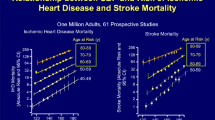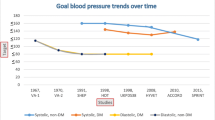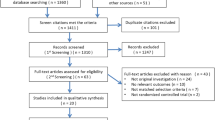Abstract
Purpose of Review
The definition and treatment of hypertension have both changed dramatically over the last century, with recent trials suggesting benefit for lower blood pressure (BP) targets than ever before considered. However, tempering the enthusiasm for more intensive BP targets are long-held concerns that BP reduction below a certain threshold may pose dangers, the so-called “J-curve.” In this review, we summarize the evidence for a J-curve in the treatment of hypertension.
Recent Findings
The Systolic Blood Pressure Intervention Trial (SPRINT) reported that achieving a systolic BP target of 120 mmHg reduces cardiovascular disease in high-risk individuals, supporting more intensive BP reduction. However, contemporary observational studies consistently demonstrate a BP J-curve, the threshold of which is often close to the SPRINT target. Studies also suggest that the BP level of this J-curve may vary based on patient characteristics, including age and comorbidities. There is also more compelling evidence for the specific presence of a J-curve between diastolic BP and coronary events, in contrast to conflicting evidence of a J-curve with systolic BP and cardiovascular disease more generally.
Summary
There is increased risk of coronary events below a diastolic BP of 60–70 mmHg. In comparison, the presence of a systolic J-curve is less clear and some persons at high risk may actually benefit from systolic levels down to 120 mmHg. Therefore, we suggest a personalized approach to BP management considering individual risks, benefits, and preferences when choosing therapeutic targets. Further, well-designed studies are required to support our suggestions and to define J-curve thresholds more clearly.
Similar content being viewed by others
References
Papers of particular interest, published recently, have been highlighted as: • Of importance
Benjamin EJ, Blaha MJ, Chiuve SE, Cushman M, Das SR, Deo R,et al. American Heart Association Statistics Committee and Stroke Statistics Subcommittee. Heart Disease and Stroke Statistics-2017 Update: A Report From the American Heart Association. Circulation. 2017 Mar 7;135(10):e146-e603. doi:10.1161/CIR.0000000000000485.
Whelton PK, Chen J, Krousel-Wood M. Lessons learned from systolic blood pressure intervention trial. Curr Opin Cardiol. 2017; doi:10.1097/HCO.0000000000000396.
Edgecombe W. The significance, treatment, and prognosis of high blood-pressure. Proc R Soc Med. 1913;6(Balneol Climatol Sect):77–95.
Goldie W. Hypertension and its relationship to the functional activities of the vessels. Can Med Assoc J. 1924;14(9):836–41.
Mahmood SS, Levy D, Vasan RS, Wang TJ. The Framingham Heart Study and the epidemiology of cardiovascular disease: a historical perspective. Lancet. 2014;383(9921):999–1008. doi:10.1016/S0140-6736(13)61752-3.
Dawber TR, Moore FE, Mann GV. Coronary heart disease in the Framingham study. Am J Public Health Nations Health. 1957;47(4 Pt 2):4–24.
Stewart IM. New prospects in the treatment of hypertension. Lancet. 1957;273(6999):753–6.
Morris JN, Kagan A, Pattison DC, Gardner MJ. Incidence and prediction of ischaemic heart-disease in London busmen. Lancet. 1966;2(7463):553–9.
Paul O, Lepper MH, Phelan WH, Dupertuis GW, Macmillan A, Mc KH, et al. A longitudinal study of coronary heart disease. Circulation. 1963;28:20–31.
Veterans Administration Cooperative Study Group on Antihypertensive Agents. Effects of treatment on morbidity in hypertension. Results in patients with diastolic blood pressures averaging 115 through 129mm Hg. JAMA. 1967;202(11):1028–34.
Veterans Administration Cooperative Study Group on Antihypertensive Agents. Effects of treatment on morbidity in hypertension. II. Results in patients with diastolic blood pressure averaging 90 through 114 mm Hg. JAMA. 1970;213(7):1143–52.
Hypertension Detection and Follow-up Program Cooperative Group. Five-year findings of the hypertension detection and follow-up program. I. Reduction in mortality of persons with high blood pressure, including mild hypertension. JAMA. 1979;242(23):2562–71.
The Australian therapeutic trial in mild hypertension. Report by the Management Committee. Lancet. 1980;1(8181):1261–7.
MRC trial of treatment of mild hypertension: principal results. Medical Research Council Working Party. Br Med J (Clin Res Ed). 1985;291(6488):97–104.
Report of the Joint National Committee on detection, evaluation, and treatment of high blood pressure. A cooperative study. JAMA. 1977;237(3):255–61.
The 1980 report of the Joint National Committee on detection, evaluation, and treatment of high blood pressure. Arch Intern Med. 1980;140(10):1280–5.
Amery A, Birkenhager W, Brixko P, Bulpitt C, Clement D, Deruyttere M, et al. Mortality and morbidity results from the European Working Party on High Blood Pressure in the Elderly trial. Lancet. 1985;1(8442):1349–54.
SHEP Cooperative Research Group. Prevention of stroke by antihypertensive drug treatment in older persons with isolated systolic hypertension. Final results of the Systolic Hypertension in the Elderly Program (SHEP). JAMA. 1991;265(24):3255–64.
Staessen JA, Fagard R, Thijs L, Celis H, Arabidze GG, Birkenhager WH, et al. Randomised double-blind comparison of placebo and active treatment for older patients with isolated systolic hypertension. The Systolic Hypertension in Europe (Syst-Eur) Trial Investigators. Lancet. 1997;350(9080):757–64.
Beckett NS, Peters R, Fletcher AE, Staessen JA, Liu L, Dumitrascu D, et al. Treatment of hypertension in patients 80 years of age or older. N Engl J Med. 2008;358(18):1887–98. doi:10.1056/NEJMoa0801369.
ALLHAT Collaborative Research Group. Major cardiovascular events in hypertensive patients randomized to doxazosin vs chlorthalidone: the antihypertensive and lipidlowering treatment to prevent heart attack trial (ALLHAT). JAMA. 2000;283(15):1967–75.
Lewington S, Clarke R, Qizilbash N, Peto R, Collins R, Prospective SC. Age-specific relevance of usual blood pressure to vascular mortality: a meta-analysis of individual data for one million adults in 61 prospective studies. Lancet. 2002;360(9349):1903–13.
Ikonomidis I, Makavos G, Lekakis J. Arterial stiffness and coronary artery disease. Curr Opin Cardiol. 2015;30(4):422–31. doi:10.1097/HCO.0000000000000179.
Lucas SJ, Tzeng YC, Galvin SD, Thomas KN, Ogoh S, Ainslie PN. Influence of changes in blood pressure on cerebral perfusion and oxygenation. Hypertension. 2010;55(3):698–705. doi:10.1161/HYPERTENSIONAHA.109.146290.
Bhatt DL. Troponin and the J-curve of diastolic blood pressure: when lower is not better. J Am Coll Cardiol. 2016;68(16):1723–6. doi:10.1016/j.jacc.2016.08.007.
Stewart IM. Long-term observations on high blood-pressure presenting in fit young men. Lancet. 1971;1(7695):355–8.
Black HR. The coronary artery disease paradox. Am J Hypertens. 1996;9(4 Pt 3):2S–10S.
D'Agostino RB, Belanger AJ, Kannel WB, Cruickshank JM. Relation of low diastolic blood pressure to coronary heart disease death in presence of myocardial infarction: the Framingham Study. BMJ. 1991;303(6799):385–9.
Anderson TW. Re-examination of some of the Framingham blood-pressure data. Lancet. 1978;2(8100):1139–41.
• McEvoy JW, Chen Y, Rawlings A, Hoogeveen RC, Ballantyne CM, Blumenthal RS, et al. Diastolic blood pressure, subclinical myocardial damage, and cardiac events: implications for blood pressure control. J Am Coll Cardiol. 2016;68(16):1713–22. doi:10.1016/j.jacc.2016.07.754. Observational study in the ARIC cohort showing that low diastolic blood pressure is associated with subclinical myocardial damage with troponin leak, and on long-term follow-up associated with adverse cardiovascular outcomes.
Cruickshank JM. Antihypertensive treatment and the J-curve. Cardiovasc Drugs Ther. 2000;14(4):373–9.
• Cruickshank JM, Thorp JM, Zacharias FJ. Benefits and potential harm of lowering high blood pressure. Lancet. 1987;1(8533):581–4. Early observational study highlighting the potential harms of aggressive diastolic blood pressure lowering.
• Vidal-Petiot E, Ford I, Greenlaw N, Ferrari R, Fox KM, Tardif JC, et al. Cardiovascular event rates and mortality according to achieved systolic and diastolic blood pressure in patients with stable coronary artery disease: an international cohort study. Lancet. 2016;388(10056):2142–52. doi:10.1016/S0140-6736(16)31326-5. Large contemporary observational study demonstrating a diastolic and systolic J-curve in patients with coronary artery disease.
Kannel WB, Wilson PW, Nam BH, D'Agostino RB, Li J. A likely explanation for the J-curve of blood pressure cardiovascular risk. Am J Cardiol. 2004;94(3):380–4. doi:10.1016/j.amjcard.2004.04.043.
Messerli FH, Mancia G, Conti CR, Hewkin AC, Kupfer S, Champion A, et al. Dogma disputed: can aggressively lowering blood pressure in hypertensive patients with coronary artery disease be dangerous? Ann Intern Med. 2006;144(12):884–93.
Pepine CJ, Handberg EM, Cooper-DeHoff RM, Marks RG, Kowey P, Messerli FH, et al. A calcium antagonist vs a non-calcium antagonist hypertension treatment strategy for patients with coronary artery disease. The International Verapamil-Trandolapril Study (INVEST): a randomized controlled trial. JAMA. 2003;290(21):2805–16. doi:10.1001/jama.290.21.2805.
Farnett L, Mulrow CD, Linn WD, Lucey CR, Tuley MR. The J-curve phenomenon and the treatment of hypertension. Is there a point beyond which pressure reduction is dangerous? JAMA. 1991;265(4):489–95.
Hansson L, Zanchetti A, Carruthers SG, Dahlof B, Elmfeldt D, Julius S, et al. Effects of intensive blood-pressure lowering and low-dose aspirin in patients with hypertension: principal results of the Hypertension Optimal Treatment (HOT) randomised trial. HOT Study Group. Lancet. 1998;351(9118):1755–62.
Messerli FH, Panjrath GS. The J-curve between blood pressure and coronary artery disease or essential hypertension: exactly how essential? J Am Coll Cardiol. 2009;54(20):1827–34. doi:10.1016/j.jacc.2009.05.073.
Rabkin SW, Waheed A, Poulter RS, Wood D. Myocardial perfusion pressure in patients with hypertension and coronary artery disease: implications for DBP targets in hypertension management. J Hypertens. 2013;31(5):975–82. doi:10.1097/HJH.0b013e32835e831c.
Polese A, De Cesare N, Montorsi P, Fabbiocchi F, Guazzi M, Loaldi A, et al. Upward shift of the lower range of coronary flow autoregulation in hypertensive patients with hypertrophy of the left ventricle. Circulation. 1991;83(3):845–53.
• Bohm M, Schumacher H, Teo KK, Lonn EM, Mahfoud F, Mann JF, et al. Achieved blood pressure and cardiovascular outcomes in high-risk patients: results from ONTARGET and TRANSCEND trials. Lancet. 2017; doi:10.1016/S0140-6736(17)30754-7. Post-hoc analyses of two randomized trials of patients with coronary artery disease again confirming the adverse outcomes of diastolic blood pressure.
Group AS, Cushman WC, Evans GW, Byington RP, Goff DC Jr, Grimm RH Jr, et al. Effects of intensive blood-pressure control in type 2 diabetes mellitus. N Engl J Med. 2010;362(17):1575–85. doi:10.1056/NEJMoa1001286.
Reboldi G, Gentile G, Angeli F, Ambrosio G, Mancia G, Verdecchia P. Effects of intensive blood pressure reduction on myocardial infarction and stroke in diabetes: a meta-analysis in 73,913 patients. J Hypertens. 2011;29(7):1253–69. doi:10.1097/HJH.0b013e3283469976.
Mancia G, Schumacher H, Redon J, Verdecchia P, Schmieder R, Jennings G, et al. Blood pressure targets recommended by guidelines and incidence of cardiovascular and renal events in the Ongoing Telmisartan Alone and in Combination With Ramipril Global Endpoint Trial (ONTARGET). Circulation. 2011;124(16):1727–36. doi:10.1161/CIRCULATIONAHA.110.008870.
Cooper-DeHoff RM, Gong Y, Handberg EM, Bavry AA, Denardo SJ, Bakris GL, et al. Tight blood pressure control and cardiovascular outcomes among hypertensive patients with diabetes and coronary artery disease. JAMA. 2010;304(1):61–8. doi:10.1001/jama.2010.884.
Ovbiagele B, Diener HC, Yusuf S, Martin RH, Cotton D, Vinisko R, et al. Level of systolic blood pressure within the normal range and risk of recurrent stroke. JAMA. 2011;306(19):2137–44. doi:10.1001/jama.2011.1650.
Group SR, Wright JT Jr, Williamson JD, Whelton PK, Snyder JK, Sink KM, et al. A randomized trial of intensive versus standard blood-pressure control. N Engl J Med. 2015;373(22):2103–16. doi:10.1056/NEJMoa1511939.
Williamson JD, Supiano MA, Applegate WB, Berlowitz DR, Campbell RC, Chertow GM, et al. Intensive vs standard blood pressure control and cardiovascular disease outcomes in adults aged >/=75 years: a randomized clinical trial. JAMA. 2016;315(24):2673–82. doi:10.1001/jama.2016.7050.
Boshuizen HC, Izaks GJ, van Buuren S, Ligthart GJ. Blood pressure and mortality in elderly people aged 85 and older: community based study. BMJ. 1998;316(7147):1780–4.
Tervahauta M, Pekkanen J, Enlund H, Nissinen A. Change in blood pressure and 5-year risk of coronary heart disease among elderly men: the Finnish cohorts of the Seven Countries Study. J Hypertens. 1994;12(10):1183–9.
• Lonn EM, Bosch J, Lopez-Jaramillo P, Zhu J, Liu L, Pais P, et al. Blood-pressure lowering in intermediate-risk persons without cardiovascular disease. N Engl J Med. 2016;374(21):2009–20. doi:10.1056/NEJMoa1600175. Recent randomized control trial further supporting the idea that the benefit of aggressive systolic blood pressure control may be related to underlying patient risk.
Blood Pressure Lowering Treatment Trialists C, Sundstrom J, Arima H, Woodward M, Jackson R, Karmali K, et al. Blood pressure-lowering treatment based on cardiovascular risk: a meta-analysis of individual patient data. Lancet. 2014;384(9943):591–8. doi:10.1016/S0140-6736(14)61212-5.
McEvoy JW, Martin SS, Dardari ZA, Miedema MD, Sandfort V, Yeboah J, et al. Coronary artery calcium to guide a personalized risk-based approach to initiation and intensification of antihypertensive therapy. Circulation. 2016; doi:10.1161/CIRCULATIONAHA.116.025471.
Pokharel Y, Sun W, de Lemos JA, Taffet GE, Virani SS, Ndumele CE, et al. High-sensitivity troponin T and cardiovascular events in systolic blood pressure categories: atherosclerosis risk in communities study. Hypertension. 2015;65(1):78–84. doi:10.1161/HYPERTENSIONAHA.114.04206.
Selvaraj S, Steg PG, Elbez Y, Sorbets E, Feldman LJ, Eagle KA, et al. Pulse pressure and risk for cardiovascular events in patients with atherothrombosis: from the REACH registry. J Am Coll Cardiol. 2016;67(4):392–403. doi:10.1016/j.jacc.2015.10.084.
James PA, Oparil S, Carter BL, Cushman WC, Dennison-Himmelfarb C, Handler J, et al. 2014 evidence-based guideline for the management of high blood pressure in adults: report from the panel members appointed to the Eighth Joint National Committee (JNC 8). JAMA. 2014;311(5):507–20. doi:10.1001/jama.2013.284427.
Siu AL. Force USPST. Screening for high blood pressure in adults: U.S. Preventive Services Task Force recommendation statement. Ann Intern Med. 2015;163(10):778–86. doi:10.7326/M15-2223.
Rosendorff C, Lackland DT, Allison M, Aronow WS, Black HR, Blumenthal RS, et al. Treatment of hypertension in patients with coronary artery disease: a scientific statement from the American Heart Association, American College of Cardiology, and American Society of Hypertension. J Am Soc Hypertens. 2015;9(6):453–98. doi:10.1016/j.jash.2015.03.002.
Go AS, Bauman MA, Coleman King SM, Fonarow GC, Lawrence W, Williams KA, et al. An effective approach to high blood pressure control: a science advisory from the American Heart Association, the American College of Cardiology, and the Centers for Disease Control and Prevention. Hypertension. 2014;63(4):878–85. doi:10.1161/HYP.0000000000000003.
Kovell LC, Ahmed HM, Misra S, Whelton SP, Prokopowicz GP, Blumenthal RS, et al. US Hypertension management guidelines: a review of the recent past and recommendations for the future. J Am Heart Assoc. 2015;4(12). pii: e002315. doi:10.1161/JAHA.115.002315
Merai R, Siegel C, Rakotz M, Basch P, Wright J, Wong B, et al. CDC grand rounds: a public health approach to detect and control hypertension. MMWR Morb Mortal Wkly Rep. 2016;65(45):1261–4. doi:10.15585/mmwr.mm6545a3.
Writing Group M, Mozaffarian D, Benjamin EJ, Go AS, Arnett DK, Blaha MJ, et al. Executive summary: heart disease and stroke statistics—2016 update: a report from the American Heart Association. Circulation. 2016;133(4):447–54. doi:10.1161/CIR.0000000000000366.
Author information
Authors and Affiliations
Corresponding author
Ethics declarations
Conflict of Interest
Faisal Rahman and John W. McEvoy declare that they have no conflicts of interest.
Human and Animal Rights and Informed Consent
This article does not contain any studies with human or animal subjects performed by any of the authors.
Additional information
This article is part of the Topical Collection on Coronary Heart Disease
Rights and permissions
About this article
Cite this article
Rahman, F., McEvoy, J.W. The J-shaped Curve for Blood Pressure and Cardiovascular Disease Risk: Historical Context and Recent Updates. Curr Atheroscler Rep 19, 34 (2017). https://doi.org/10.1007/s11883-017-0670-1
Published:
DOI: https://doi.org/10.1007/s11883-017-0670-1




